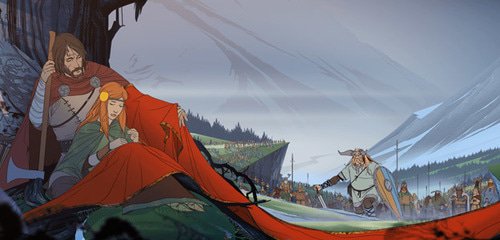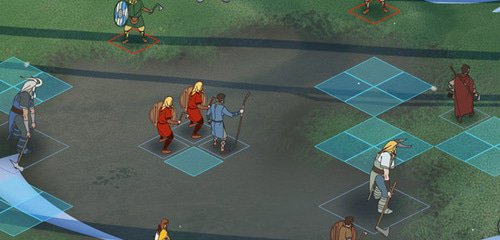Main Menu
Reviews
The Banner Saga Review

By Andrew Matt
Score: 8.4
The sun has stopped in the sky, your caravan of clansmen are starving to death and dwindling in numbers every day, you just lost one of your best warriors in an accident where an oxen cart fell off a cliffside, and to make matters worse, you have an army of indomitable foes slowly advancing on your rear. As your procession continues through the never-ending daytime, screams are heard behind you. Fear rattles through your bones. Have you been ambushed by brigands or has something even worse happened? You investigate only to find that the commotion is over a woman that has entered labor, giving birth to her first child. You stop the long march for the day and make camp, cracking open what barrels of mead you have left to celebrate new life in a time of ceaseless death.
The Banner Saga is not a game filled with rainbows and sunshine, and is hardly for the feint of heart. There is no feel-good story here, no savior with a magical sword to make everything better; hell, even the gods that existed in this universe have all died murdering each other. What Stoic Studio presents before you is a game of tough decisions that makes it a point of giving you poignant reminders of the current dire and dreary state of affairs you are living in.
From the onset, you are thrust into the thick of things with little to no hand holding or background information. Much of the lore here is presented to you over time, as the intricacies of the relationship between humans and Varl-giants that resemble humans with goat-like horns protruding from their foreheads-are revealed. Perspective jumps between three different characters in the opening chapters, making things a touch convoluted, but not impossible to follow. In the second half of the game, things settle down and the previous events are threaded together into a story that has a decisive beginning, middle, and end.
The perspectives you shift between are all chieftains to their respective group of followers, tasked with leading them through dark forests, barren landscapes, and over mountainsides, facing various challenges that crop up in your journey between the worlds cities and small villages. The execution is fairly reminiscent of Oregon Trail, tracking the number of people in your convoy, the number of days left of supplies you have to feed them, and the time that has passed. The larger the number of people in your caravan, the longer your procession will appear and the larger your banners will become, while losing clansman to death and abandonment will shrink your size to a handful of people and diminish your banners drastically.
As time passes, text boxes will pop up with decisions to be made that can have far reaching consequences. Welcoming stray travelers into your party may increase your numbers, but at the first sign of trouble they might abandon you and take your supplies with them in the process. This leaves you with a march that will last several days before reaching your next city with no food to feed your followers with, forcing you to slowly watch your numbers decrease as starvation takes its toll. It's a simple system, but it makes you care, and punches you in the gut when you make decisions that take your host of 500 people to less than a hundred. Some of these decisions presented to you can even end with the death of core party members, and many others will simply lead to conflicts that will make you question your choices, with many outcomes coming out somewhere in the gray.

Inevitable confrontations lead to the game's combat system that will feel familiar to veterans of the tactical RPG genre. You set up units on a grid of square tiles before readying yourself for battle, with units alternating turns to move across the battlefield to slay all the enemies on the board. Each unit in The Banner Saga has an armor and strength attribute that determines their overall durability and damage-dealing capacity. A unit can only deal damage equal to their strength minus their target's armor when attacking. Many times this number won't be large enough to deal reliable damage and will require you to instead attack the unit's armor directly to wear it down and make them vulnerable to lethal damage.
"Even hours after completing the game, I still can't decide if the art better compliments the music or vice versa."
The technique in execution works well enough, but can fall flat at times. The AI punishes reckless play consistently, and in the early portions of the game, it was not uncommon for me to outright lose my confrontations until I adjusted to the game and began targeting armor to soften up my foes to deal major damage on later turns. Smart tactics like using the Varl, which occupy four square tiles, as pillars to constrict movement and tank damage allowed me to use human archers to lay waste to the battlefield when played correctly. However, when things go awry-which frequently happens on normal and hard difficulty-battles can quickly become wars of attrition. Random difficulty spikes can leave your party annihilated, often times leaving you with archers backpedaling every turn, desperately trying to break through a large amount of armor and avoid being one-shotted by larger enemies. Varl can frequently get into slap fights with foes that can wind down to a simple number game of who-hit-who-first inevitably winning. It's rewarding when everything clicks, but frustrating when it doesn't, making combat a very hit-or-miss experience.
These small issues are accentuated by characters' depth off the playing field. Each unit can level up by killing a set number of foes in battle, with a cap at level five. The leveling system doesn't make it particularly obvious as to what attributes you should focus on in the early hours of the game, but more importantly it makes no precedence to level particular characters. This was particularly frustrating at the end of the game, where two characters are forced into your party for the final confrontation. If you didn't deem them worthy of using regularly and have them at a low level, the final fight can be nigh impossible on anything above easy difficulty. Items can also be purchased and equipped onto characters, but potentially gimped progression without rotating units to gain experience every battle and no way to grind characters to the level cap a la Fire Emblem, the investment didn't seem worthwhile in my 16-hour playthrough.
Despite a few minor flaws in combat and character progression, it does little to take away from The Banner Saga's crowning achievement: masterful presentation. As a whole, cohesive piece, The Banner Saga creates a world that has consistent tone from beginning to end. The art by Arnie Jorgensen reminds me of Ralph Bakshi's 1978 animated Lord of the Rings film, with each character having their own striking resemblance. The majestic backdrops your caravan crosses are equally well detailed and stunning in their own regard. Accented by a soundtrack by Austin Winory, whose work on Journey earned a grammy nomination in 2012, brings simple strings, drums, and vocal work together in what I personally consider to be his best work yet. Even hours after completing the game, I still can't decide if the art better compliments the music or vice versa.
The Banner Saga overall is a joy of an experience. A slightly confusing start mixed with a bit of hit-or-miss combat can not be held back by the tough decision-making you must go through, the amazing art design, and the magnificent soundtrack that creates one of the most tonally consistent games I have ever played. Even after completing the near 16-hour campaign, you'll surely be left wanting more when the dust settles in what is a truly gripping first act in this Norse-inspired trilogy.





